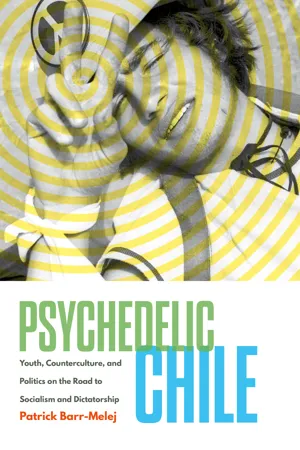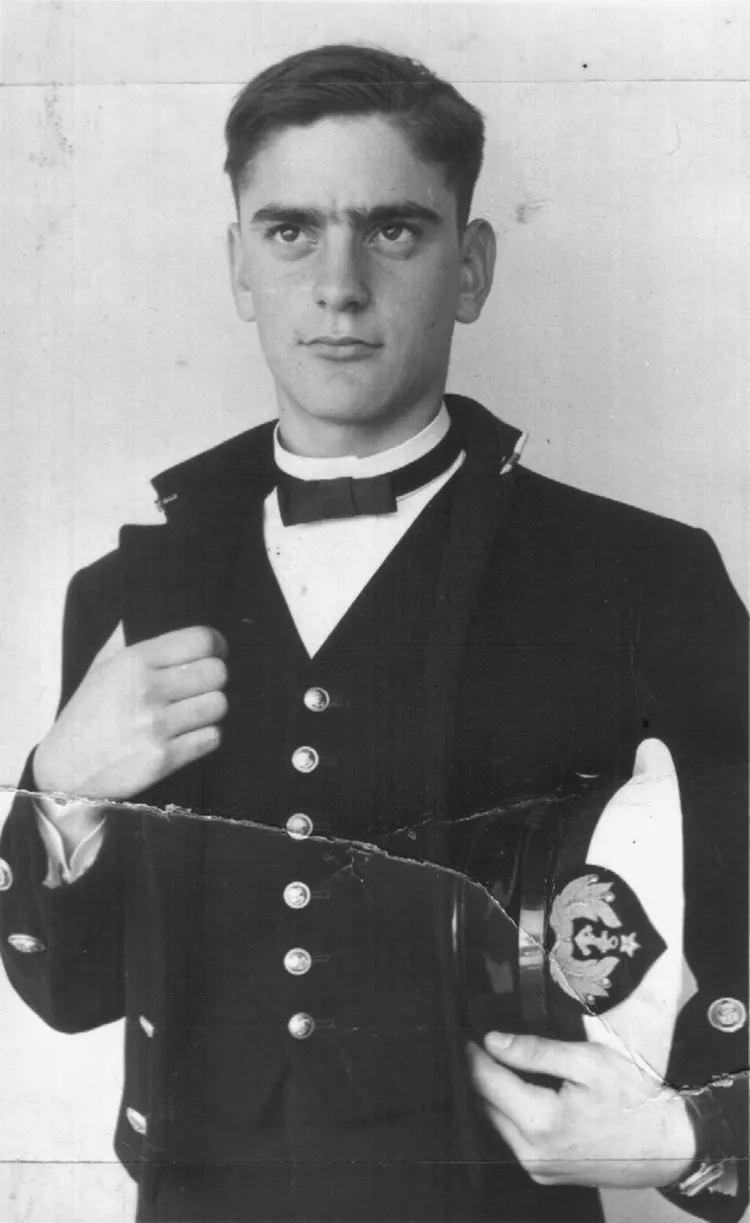![]()
1 The Opening Set
Young Jorge and the Criollo Woodstock
Some five thousand or so young people—many wearing bandanas, sunglasses, bell-bottom pants, and garments emblazoned with peace signs and carrying marijuana and contraceptive wares of one kind or another—gathered over the holiday weekend of October 10–12, 1970, on a private parcel of land in what now is a posh sector of Greater Santiago’s eastern reaches.1 A good number of them pitched large tents as well as their clothes, made both bonfires and love, and took in marijuana’s smoke and the electrified sounds of local rock bands such as Los Jaivas and Los Blops. As one festivalgoer later recalled, “Anybody of that age who wasn’t, oh, I don’t know, particularly stuck in a different world, was out in that sort of expressive [environment] of experimenting with new ideas, new ways of being.… I think it was kind of a radical movement of free expression and so forth, so I was certainly doing that as much as anybody else was.”2 For many, the festival was a deeply formative experience, as they forged enduring relationships, fell in love, enjoyed the feeling of having bucked parental authority, and learned more about themselves. To numerous young people who missed it, the festival nevertheless became a symbol of the potential, promise, and consequences of pursuing different ways of thinking and acting in their society. At the same time, Piedra Roja provoked an outpouring of dismay and anger from foes of hippismo and counterculture, as families, the media, politicians, and others depicted what the festival was and meant—or what they thought it was and meant.
Piedra Roja’s very existence essentially questioned the cultural conventions and broader sensibilities of an older generation in power, and as an expression of the criollo counterculture’s emergence, it revealed that a growing number of youths in the sixties and seventies found meaning in ideas that were recalcitrant, amorphous, contradictory, nondoctrinal, spontaneous, and expansive—and therefore quite attractive. The organizers, musicians, the so-called marihuaneros (potheads), and the vibes of Piedra Roja revealed “revolutionary” dispositions and new values through inference and practice rather than a totalizing theory. Shared outlooks, like smoke, wafted in the air. The stories of Jorge Gómez Ainslie and his festival provide us inceptive peeks into what countercultural young people were thinking, hoping, wanting, and doing, and they bring forth some attributes of the society, mainstream culture, and political culture in which those youths lived. Gómez and others found themselves the targets of widespread rebuke (and sometimes punishment) even though the festival fell quite short of the grooviness envisioned by its protagonists, including the very rock music groups that made Piedra Roja a rock festival. Just as the festival began with young Jorge, our discussion shall as well.
Young Jorge
Jorge Gómez was a disillusioned adolescent in the late 1960s, but hardly an apathetic one. Born to a Chilean father and Scottish mother (hence the matronymic “Ainslie”) in Santiago in 1951, he had returned to Chile’s capital in 1967 after having lived in England for a dozen years—the England of John, Paul, Ringo, and George, not to mention the Rolling Stones, the Kinks, and many others. He was sixteen, fresh from a boarding school in Surrey, and experiencing “culture shock,” he explained, in a society both foreign and familiar to him, and where the clock of cultural change seemed to be running slow. Some three years after arriving in Chile, young Jorge returned the favor of a culture shock, and he did so, in part, due to what he later called his “long and sad” history in Chilean schooling. “I was bored with it all,” Gómez described.3 His story is largely unique among Chilean youths of the 1960s and early 1970s; the vast majority never lived abroad or, for that matter, never organized a momentous rock festival. Yet, young Jorge and a good many of his generational brothers and sisters shared similar sentiments—boredom and rebelliousness, for instance—that drew the attention of figures in government and academia, among other circles.
After departing Surrey in his fifth year of secondary school, Jorge was wondering what to make of a new life in Santiago. To his family’s dismay, the Chilean Ministry of Education declared it would not fully accept and credit Jorge’s secondary-school years in England, citing differences in educational emphases and scope. The ministry ordered Jorge to begin secondary schooling almost anew. “I had arrived in Chile with all the certificates and documents from my [English] school,” Gómez recalled. “I practically lost four years.” The experience weighed heavily on Jorge as his resentment grew toward authority and institutions, especially the one that negated his English credits. His thoughts wandered. In 1969, after Jorge’s nearly two years of playing catch-up in high school, and amid his growing rebelliousness, his parents dictated two options: enter a Chilean boarding school (quite possibly the Barros Arana Boarding School, where his father had studied) or join the armed forces. “It wasn’t going well for me in my house with my parents. They were very strict and I was feeling beaten down by society,” Gómez remarked. The thought of attending Barros Arana was “terrible” enough for Jorge to choose entry into the Naval Academy at Valparaíso, even though the academy would only reinforce and intensify his ongoing frustration regarding institutions of authority. Soon, Jorge butted up against the state’s intransigence once again. What his parents viewed as a step forward in Jorge’s maturation was, they came to find out, another academic leap backward: the Naval Academy did not recognize Jorge’s two years of coursework that he had undertaken—in a Chilean high school, no less—in order to make up for the years of schooling in Surrey that had been lost thanks to the Ministry of Education.4 Almost eighteen at the time, he was back to square one. Once at the academy, young Jorge realized (unsurprisingly) that military life was not for him: “I made them throw me out [in late 1969] because I couldn’t stand it,” Gómez explained. His academy days were positive in at least one respect: Inspired by news of the 1969 Woodstock festival, he and some fellow cadets formed an ephemeral rock band, with Jorge the lead singer.
Expelled from the Naval Academy in 1969, Jorge was to resume public secondary schooling at the behest of his concerned parents. However, news from the Ministry of Education again left the Gómez family exasperated: the ministry did not accept the academic credits Jorge earned at the academy. Once more, a bureaucratic sinkhole had swallowed Jorge. “From the time I arrived from England, I was confronted by the bureaucracy,” Gómez noted. Dismayed and gripped by deepening alienation, Jorge understood his ongoing conflict with the state’s bureaucracy in generational terms more than anything else, very much like he understood his growing conflicts with his parents.5 With his options dwindling, he began attending Liceo No. 11 in Las Condes (now called the Liceo Rafael Sotomayor) as an oyente, or auditing student. At nineteen, then, Jorge was sitting in on classes and bored out of his wits by lessons that were years behind his intellectual capacity. One consolatory aspect of the Liceo No. 11, however, was its reputation as “the aerodrome of Las Condes—for its joints, and many of them,” Gómez remembered. And while breathing the air of Liceo No. 11, young Jorge pondered and coordinated an event, a spectacle, which would be long remembered—by Jorge and by a society. Indeed, more than four decades after his criollo Woodstock, Gómez, who remains a loyal fan of Jimi Hendrix, Bob Dylan, and other icons of the 1960s and early 1970s, routinely fields telephone calls from journalists and radio stations seeking interviews about a weekend in the spring of 1970 that left an indelible mark on the shared memory of a generation of Chileans. “It ended up being a unique phenomenon,” Gómez explained. “It never happened again and, obviously, today they wouldn’t give permission for such a thing.”6
Jorge Gómez at seventeen, in his Navy cadet uniform (1969). His subsequent expulsion from the academy marked yet another difficult chapter in his relationship with “authority.” Courtesy of Jorge Gómez Ainslie.
For all intents and purposes, Jorge was a hippie by 1970, although his hair was not as long as it would be in subsequent years, when he took up residence in a hippie community in the foothills of the Andes Mountains. In the months before Piedra Roja, he hung out with fellow hippie types—“people who’d get together and thought about things differently [than the mainstream],” Gómez recalled—at countercultural haunts in Greater Santiago’s municipality of Providencia and elsewhere. Jorge was, in short, a “hippie by heart” rather than a “weekend hippie,” or the type who feigned hippismo in order to fit in with a hip crowd. Strongly influenced by foreign counterculture and having witnessed beat- and rock-music scenes firsthand during his final months in England, Jorge also immersed himself in Santiago’s expanding rock sphere, elements of which appeared on a rickety stage at Piedra Roja. The music of such criollo rock groups as Los Jaivas and Los Blops dovetailed with the young man’s admiration of the Rolling Stones and Jimi Hendrix, billowing and mixing in his mind with imaginings of a festival that, Gómez reminisced, came to pass by way of faith, conviction, and idealism.
Setting the Stage
Much of the inspiration to hold a criollo Woodstock struck the intrepid young Jorge and some friends while they were at the movies. During September and October of 1970, the well-known documentary about New York’s festival, Woodstock: Three Days of Peace and Music, appeared in some of Santiago’s cinemas, including the Cine Las Condes on Apoquindo Avenue, not terribly far from the Gómez home on Vitacura Avenue and Liceo No. 11.7 Young Chileans who were curious about counterculture, in addition to youths who already were living it as best they could, sat in those local theaters and together witnessed the unfolding drama that was the Woodstock extravaganza, with naked men and women, drugs of all kinds (including LSD), and tens of thousands of communing hippies in living color. Sources of inspiration did not stop there. Since the late 1960s, Chilean magazines and newspapers had been commenting, here and there and usually in negative or ambivalent ways, on what countercultural youths were up to in other Latin American countries and around the globe, thus bringing that world closer to readers young and older. Moreover, less than a week before Piedra Roja took shape, and with timing that was as perfect as it was coincidental, one of the Woodstock film’s (and festival’s) performers, Country Joe McDonald of Country Joe and the Fish, arrived in Santiago to participate in the production of a new film—part spy story, part musical, part documentary—called ¿Qué Hacer? (What Is to Be Done?) which was co-directed by U.S. filmmaker and political activist Saul Landau.8 Country Joe did not make an appearance at Piedra Roja, but his arrival made news in periodicals that young people riffled through at any curbside kiosk. In a manner of speaking, Woodstock became three dimensional upon Country Joe’s arrival.
With Woodstock, frustration, boredom, and hippismo on his mind, Jorge found motivation in September 1970 to create a modest event that would bring together perhaps five hundred or so young people who were drawn, like Jorge, to local rock and counterculture. With friends Andrés Lewin and Roberto Cherit, Jorge asked Liceo No 11’s Student Council to sponsor a festival. Their pitch failed, likely due to doubts among student leaders that Jorge could pull it off. Undeterred, Jorge, Andrés, Roberto, and others, including a few American ...

